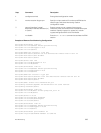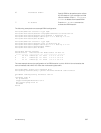
The reserved VLANs transport the mirrored traffic in sessions (blue pipes) to the destination analyzers in
the local network. Two destination sessions are shown: one for the reserved VLAN that transports
orange-circle traffic; one for the reserved VLAN that transports green-circle traffic.
Configuring Remote Port Mirroring
Remote port mirroring requires a source session (monitored ports on different source switches), a
reserved tagged VLAN for transporting mirrored traffic (configured on source, intermediate, and
destination switches), and a destination session (destination ports connected to analyzers on destination
switches).
Configuration Notes
When you configure remote port mirroring, the following conditions apply:
• You can configure any switch in the network with source ports and destination ports, and allow it to
function in an intermediate transport session for a reserved VLAN at the same time for multiple
remote-port mirroring sessions. You can enable and disable individual mirroring sessions.
• BPDU monitoring is not required to use remote port mirroring.
• A remote port mirroring session mirrors monitored traffic by prefixing the reserved VLAN tag to
monitored packets so that they are copied to the reserve VLAN.
• Mirrored traffic is transported across the network using 802.1Q-in-802.1Q tunneling. The source
address, destination address and original VLAN ID of the mirrored packet are preserved with the
tagged VLAN header. Untagged source packets are tagged with the reserve VLAN ID.
690
Port Monitoring





















